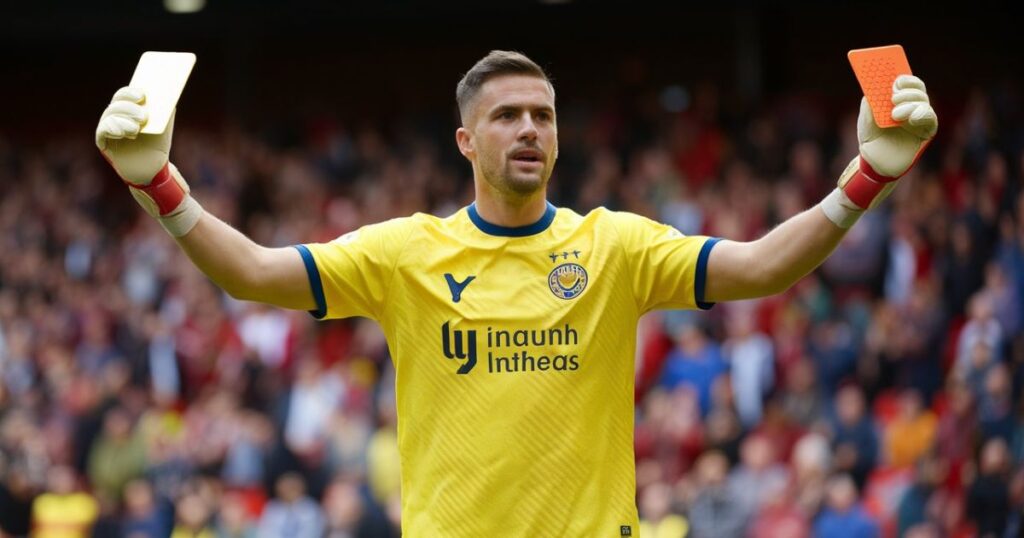In the adrenaline-fueled world of soccer, few moments carry as much weight as the sight of a player receiving a red card. This vibrant colored card may seem like a simple object, but it wields the power to dramatically shift the dynamics of a match.
If you’re new to the sport or simply seeking a deeper understanding, this comprehensive guide will unravel the meaning, consequences, and historical significance of the red card in soccer.
The Rules and Regulations Surrounding Red Cards

According to the official Laws of the Game set by the International Football Association Board (FIFA), a red card signifies one of the most severe disciplinary actions a referee can take against a player. It’s a formal ejection from the match, requiring the offending player to immediately leave the field of play.
The specific offenses that can lead to a red card include:
- Violent conduct or serious foul play
- Using offensive, insulting, or abusive language or gestures
- Spitting at an opponent or any other person
- Denying the opposing team a clear goal-scoring opportunity by deliberately handling the ball (except for goalkeepers within their penalty area)
- Receiving a second yellow card in the same match, which automatically upgrades to a red card dismissal
It’s important to note that a player can receive a straight red card for particularly egregious offenses or a red card resulting from two separate cautions (yellow cards) within the same game, known as a “second booking.”
Examples of famous incidents that illustrate these rules include:
- In the 2006 World Cup match between Portugal and Netherlands, known as the “Battle of Nuremberg,” a total of 16 yellow cards and 4 red cards were shown, leaving both teams with only 9 players on the field by the end.
- During the 2014 World Cup, Uruguay’s Luis Suárez received a straight red card for biting Italy’s Giorgio Chiellini, leading to a lengthy suspension.
Read More : How Long Is A Soccer Game? Understanding The Duration Of Soccer Matches
The Immediate Consequences of a Red Card
When a player is shown the red card, the immediate consequence is their removal from the field of play. Their team must continue the match short-handed, playing with one fewer player than the opposition.
This numerical disadvantage can be likened to running a race with one leg tied behind your back, as it significantly impacts a team’s ability to mark opponents, maintain possession, and create scoring opportunities.
Imagine a scenario where a defensive midfielder receives a red card in the 60th minute. The team must now reorganize their formation and tactics, potentially sacrificing an attacking player to reinforce their defense.
It becomes an uphill battle, requiring immense discipline, resilience, and strategic adjustments to overcome the disadvantage.
Long-term Repercussions of Red Card Offenses
Beyond the immediate impact on the match, a red card offense carries significant long-term repercussions for both the player and the team. The offending player will face a suspension from future matches, the length of which varies depending on the nature of the offense.
- A second yellow card resulting in a red card typically leads to a one-match ban.
- A straight red card for more serious offenses, such as violent conduct or denying a clear goal-scoring opportunity, often results in a three-match suspension or longer.
In addition to missing crucial games, players and clubs may also face financial penalties or disciplinary hearings for particularly egregious offenses.
Frequent red cards can also damage a team’s reputation and strain relationships with fans and sponsors. Teams with a notorious disciplinary record may be perceived as lacking sportsmanship and professionalism, potentially impacting their commercial appeal and fan support.
Red Cards for Goalkeepers – A Special Case

When a goalkeeper is sent off, it creates a unique predicament for the team. Unlike outfield players, goalkeepers cannot be easily replaced, as teams are only permitted a limited number of substitutions per match.
In such situations, teams often resort to substituting an outfield player (typically an attacker) for their reserve goalkeeper. In the past, when substitute rules were more restrictive, it was not uncommon to see outfield players donning goalkeeper gloves and attempting to fill the role, often leading to comical and chaotic scenes on the pitch.
A memorable example of this occurred in 2014 when Tottenham Hotspur’s Harry Kane, an outfield player, was forced to take over goalkeeping duties after their goalkeeper was sent off in a Europa League match against Asteras Tripoli.
The Origins and Evolution of the Red Card System
The concept of using colored cards as a disciplinary measure in soccer was introduced at the 1970 FIFA World Cup by English referee Ken Aston.
Prior to this, referees relied solely on verbal communication and gestures to convey cautions and dismissals, leading to confusion and misunderstandings.
Aston’s proposal for a yellow card to indicate a caution and a red card for ejection was initially met with skepticism.
After a notable incident in the 1962 World Cup where a sent-off player refused to leave the field due to a language barrier, the need for a clear visual system became apparent.
While the English league was initially reluctant to adopt the card system, citing concerns about fan reactions, it eventually embraced the system in 1976.
The first recorded use of a red card in English football occurred that year, with two players being dismissed in a match between Leeds United and West Bromwich Albion.
Over the years, the rules surrounding red cards have been refined and clarified by FIFA, ensuring consistency in their application across all levels of the game.
The Role of Officials in Issuing Red Cards
Referees and their team of match officials play a crucial role in maintaining discipline and enforcing the Laws of the Game, including the issuance of red cards. Effective game management requires a delicate balance between firmness and restraint.
The referee holds the ultimate authority on the field, responsible for making decisions regarding cautions, dismissals, and disciplinary actions. Clear communication and decisive action are essential when dealing with red card offenses.
Supporting the referee are the assistant referees (commonly known as linesmen), who assist in monitoring play from the sidelines and relaying information to the referee.
In recent years, the introduction of the Video Assistant Referee (VAR) has add another layer of oversight, allowing match officials to review controversial incidents and ensure accurate decisions are made, including those involving potential red card offenses.
While officials must remain impartial and enforce the rules without bias, they must also manage the game in a manner that upholds the principles of fair play and sportsmanship, using red cards as a necessary deterrent against unsportsmanlike conduct.
Conclusion
A red card in soccer is more than just a piece of plastic; it’s a symbol of the sport’s commitment to maintaining discipline, respect, and integrity on the field of play. Understanding the meaning, consequences, and historical significance of the red card is essential for players, coaches, officials, and fans alike.
As the game continues to evolve, the role of disciplinary measures like the red card will remain crucial in upholding the Laws of the Game and ensuring a level playing field for all participants.
While the issuance of a red card can be a pivotal moment in a match, it serves as a reminder that soccer is a game of skill, strategy, and sportsmanship, where respect for the rules and one’s opponents is paramount.
Looking ahead, the ongoing refinement of rules and the incorporation of technology like VAR will likely play a role in shaping the application of red cards and disciplinary actions in soccer.



